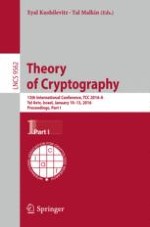2016 | OriginalPaper | Buchkapitel
On the Impossibility of Virtual Black-Box Obfuscation in Idealized Models
verfasst von : Mohammad Mahmoody, Ameer Mohammed, Soheil Nematihaji
Erschienen in: Theory of Cryptography
Verlag: Springer Berlin Heidelberg
Aktivieren Sie unsere intelligente Suche, um passende Fachinhalte oder Patente zu finden.
Wählen Sie Textabschnitte aus um mit Künstlicher Intelligenz passenden Patente zu finden. powered by
Markieren Sie Textabschnitte, um KI-gestützt weitere passende Inhalte zu finden. powered by
Abstract
-
There is no general VBB obfuscation in the generic group model of Shoup (Eurocrypt’97) for any abelian group. By applying our techniques to the setting of Pass and Shelat we extend their result to any (even non-commutative) finite ring.
-
There is no general VBB obfuscation in the random trapdoor permutation oracle model. Note that as opposed to the random oracle which is an idealized primitive for symmetric primitives, random trapdoor permutation is an idealized public-key primitive.
